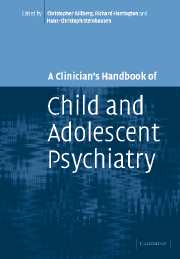Book contents
- Frontmatter
- Contents
- Preface
- List of contributors
- 1 Brain disorders
- 2 Substance use disorders
- 3 Schizophrenia and schizophrenia-like disorders
- 4 Affective disorders
- 5 Anxiety disorders
- 6 Obsessive-compulsive disorders
- 7 Adjustment disorders
- 8 Post-traumatic stress disorder
- 9 Functional somatic symptoms and somatoform disorders in children
- 10 Eating disorders: anorexia nervosa and bulimia nervosa
- 11 Sleep disorders
- 12 Personality disorders
- 13 Mental retardation/learning disability
- 14 Specific developmental disorders of speech and language
- 15 Reading and other learning disorders
- 16 Autism spectrum disorders
- 17 Hyperkinetic disorders
- 18 Conduct disorders
- 19 Elective mutism
- 20 Attachment and disorders of attachment
- 21 Tic disorders
- 22 Elimination disorders: enuresis and encopresis
- 23 Physical and sexual abuse
- 24 Gender identity disorders
- Index
- References
17 - Hyperkinetic disorders
Published online by Cambridge University Press: 06 August 2009
- Frontmatter
- Contents
- Preface
- List of contributors
- 1 Brain disorders
- 2 Substance use disorders
- 3 Schizophrenia and schizophrenia-like disorders
- 4 Affective disorders
- 5 Anxiety disorders
- 6 Obsessive-compulsive disorders
- 7 Adjustment disorders
- 8 Post-traumatic stress disorder
- 9 Functional somatic symptoms and somatoform disorders in children
- 10 Eating disorders: anorexia nervosa and bulimia nervosa
- 11 Sleep disorders
- 12 Personality disorders
- 13 Mental retardation/learning disability
- 14 Specific developmental disorders of speech and language
- 15 Reading and other learning disorders
- 16 Autism spectrum disorders
- 17 Hyperkinetic disorders
- 18 Conduct disorders
- 19 Elective mutism
- 20 Attachment and disorders of attachment
- 21 Tic disorders
- 22 Elimination disorders: enuresis and encopresis
- 23 Physical and sexual abuse
- 24 Gender identity disorders
- Index
- References
Summary
Introduction
Many children show traits of behaving in an impulsive, inattentive and restless fashion. These behaviours, when not severe, need not constitute a problem. When extreme, however, they present a risk for the psychological development of the individual. Severe levels of ‘hyperactivity’ (the combination of impulsiveness, restlessness and overactivity) make children more likely to develop an antisocial adjustment, and more likely to show various aspects of personality dysfunction in later adolescence and adult life. Children's hyperactivity can also be very unpleasant for the caregivers. Both teachers and parents can find it hard to live with a hyperactive child, and their tolerance and ability to cope may determine whether it is presented as a problem. Children with hyperactivity rarely ask for help themselves, and are often not aware of a problem. The presentation to the clinician is therefore a complex blend of the skills and tolerance of adults surrounding the child and the qualities of the children themselves. They constitute the commonest reason for referral to child mental health or behavioural paediatric services in many countries. Effective physical and psychological treatments are available, and the management needs to be long term. Hyperactive behaviour problems therefore make up a large part of the work of most community mental health services for children.
Definition and classification
ICD 10 criteria
The ICD-10 definition of hyperkinetic disorder is based upon the simultaneous presence of all three main behavioural problems: attention deficit, overactivity and impulsiveness.
- Type
- Chapter
- Information
- A Clinician's Handbook of Child and Adolescent Psychiatry , pp. 489 - 521Publisher: Cambridge University PressPrint publication year: 2006
References
- 5
- Cited by



